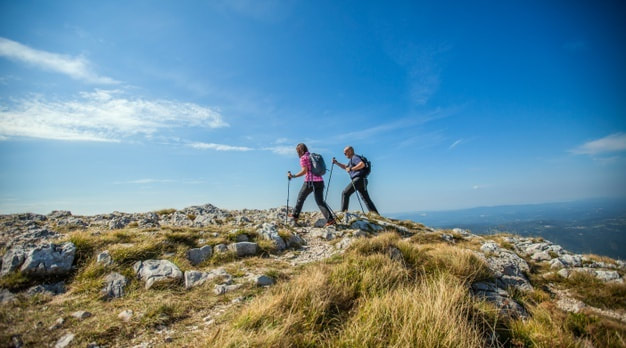|
The word “hike” has become the most often used term to describe an energizing walk in a natural environment. A hike is often a small adventure, taking up a considerable amount of the day and requiring you to have to carry water and some food or snacks in a backpack.
Hiking has several physical and mental health benefits. While some advantages are apparent, such as decreased blood pressure and stress levels and increased focus, others emerge over time, such as weight loss and depression reduction. It goes without saying that hiking is beneficial to the cardiovascular system. Even light trekking can elevate the heart rate to a healthy level, which boosts aerobic fitness and endurance. Your body rises to new fitness levels over time, and you can hike longer, faster, and harder without feeling exhausted or finding yourself out of breath. In addition, it can help improve things that are good for your heart, like your blood pressure, blood sugar levels, and cholesterol. Many studies show that regularly going for moderate hikes can cut hypertension, improve blood sugar tolerance, and lower “bad” cholesterol levels over time. Hiking is an excellent method to strengthen and maintain strong muscles and bones. Each hiking trail challenges you to adapt to varying terrain and slope angles, which means that you will be using a variety of muscle groups throughout the day. Each journey gives your body a unique challenge, whether a gentle elevation a challenging ascent, smooth or rough paths, or any combination. Inclines work the quads, hamstrings, glutes, and calves, while downhill areas work the knees and hip flexors. Wearing a backpack helps to strengthen your shoulders, arms, and back. Hiking also activates your core, the groups of muscles that stabilize your torso. Along with toning muscle, hikes are an excellent way to strengthen your bones. Weight-bearing workouts, which require you to fight against gravity, are beneficial for bone health, according to the National Institutes of Health (NIH). This is because bone, like muscle, is a living structure that becomes stronger with exercise. Activities such as hiking, walking, and running help to build bone density, strength, and overall bone mass. Hiking also increases your stability because it uses so many different muscles. It specifically engages and strengthens your hips and core, which work together to keep you stable on uneven terrain. If you are older, enhancing your balance can positively affect your overall quality of life. This becomes more critical as you age, as good balance helps lower the chances of a fall. While hiking demands physical exertion, it may also be a fantastic mental workout. Mental activities like studying maps, finding paths, and pushing through a difficult trek can be mentally taxing. After a long day of work, your mind and body need a restful night's sleep. Studies have shown that exercise can help people get a better night's sleep, and hiking is no exception. Dr. Karen Carlson, an associate professor of medicine at Harvard Medical School, states that exercise can enhance essential sleep chemicals such as melatonin. Morning sun exposure also aids in the regulation of our circadian cycles (our 24-hour sleep-wake cycle). Simply being in nature has been shown to improve mood and mental health. According to a study conducted by Stanford University researchers, spending meaningful time in nature alleviates stress, soothes anxiety, and may result in a decreased risk of depression. Being outside improves your sensory experience and opens up your senses to your environment.
0 Comments
The PGA Championship was first held in 1916, and there have been around 103 editions since then. The Professional Golfers' Association of America's Championship (also known as the US PGA Championship or US PGA outside of the United States) is an annual golf tournament held by the Professional Golfers' Association of America. It is one of professional golf's four major tournaments for men. It is an official money event with a prize of $11 million (for the 100th edition in 2018), and it has been hosted in several locations. The Professional Golfers Association of America (PGA) was founded at Siwanoy Country Club in Bronxville, New York, in February 1916. Jim Barnes, the winner, got $500 and a Rodman Wanamaker diamond-studded gold medal.
Like the other majors, winning the PGA entitles one to various benefits. For the next five years, PGA champions are automatically invited to compete in the other three majors and the Players Championship, and they are eligible for the PGA Championship for the rest of their lives. They will be eligible to play on the European Tour for the next seven and PGA Tour for the next five seasons. The PGA Championship is the only one of the four major championships open to professional golfers. The PGA Championship began as a match play event in the early fall, and it has remained so, but it may change, depending on national circumstances. Following WWII, the championship was held in late May or late June, before being shifted to early July in 1953 and a few weeks later in 1954, with the finals held on Tuesday. It was not uncommon for the finalists to play nearly 200 holes in seven days in a match play event (with a stroke-play qualification). After a loss in 1957, the event was modified to stroke play, beginning in 1958, with the usual 72-hole format of 18 holes per day over four days, Thursday through Sunday, at the PGA meetings in November. The PGA of America was pressed to change the format because network television broadcasters preferred a large group of well-known contenders on the final day. The PGA Championship was announced before the 2017 edition moved to May, the weekend before Memorial Day, starting in 2019. The PGA Tour also announced that the Players Championship would be returned to March in the same year, after being moved from March to May in 2017. The PGA of America justified the change by citing the addition of golf to the Summer Olympics, allowing a greater range of possibilities for host courses. Traditionally, the PGA Championship has been held in the eastern side of the United States. The Ocean Course at Kiawah Island Golf Resort in Kiawah Island, South Carolina, hosted the 103rd PGA Championship. New York has hosted thirteen times. The PGA has four Major Golf Tournament events during the season. Walter Hagen and Jack Nicklaus, both five-time champions, and Tiger Woods, who has won the Championship four times, are the most titled players. When professional golfers were not held in high regard in a sport dominated by wealthy amateurs, the PGA Championship was created to provide a high-profile competition, particularly for these professionals. This purpose is still reflected in the championship's entrance structure. |
AuthorJanina Casey, a finance professional in New York, has a unique professional background. ArchivesCategories |


 RSS Feed
RSS Feed
